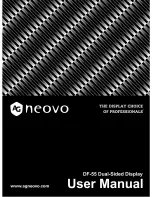
Now, any time you want to revert that camera back to its default settings simply load that
defaults settings file and apply the settings.
Incompatibility between cameras
Because the range of available settings may be different for each camera a settings file
saved when using one camera will probably not be readable when a different camera is
connected to the system. It may be by chance that a different camera has the same list of
named settings in its firmware to another camera so the settings files saved with one
camera can be loaded with the other camera attached but the ranges and effects of those
settings may differ between the two cameras. For this reason it is best to name the file
according to the camera used in that session when you save a settings file (or place that
settings file in a folder related to that camera or use some other way to identify which
camera was used when a particular settings file was generated e.g. by adding comments
to the settings file as described in the following section).
Rules for manually editing a settings file
This section may be skipped if you have no intention of manually editing a settings file.
The settings files are generated automatically by PARD Capture and must be of a
particular format to be readable by it but a settings file may be manually edited
provided
you adhere to the rules and restrictions on editing described here.
Failure to adhere to
these rules and restrictions could make the file unreadable by the program or
worse − crash the program or spoil your camera
.
For this reason it is best not to manually edit these settings files other than to insert some
comment lines for your own reference and documentation. If you feel you must edit it then
only change setting values without altering any formatting and follow all the rules
described below. If you have no intention of manually editing the file then there is no need
to learn the rules.
Comments can be inserted on any line and must start with a hash (#). Comments may
also come after ALL data on a line and must again start with a #. For example, the very
first line of an example settings file might be
PCamSet 1 20 139
but it could be modified by you to be:
PCamSet 1 20 139 # Any comment you like here ...
Bear in mind that the read buffer within PARD Capture for any line (whether a comment
line or a data line with or without a following comment) is limited to MAX_CMDLEN-1
characters (this is currently 511 characters). If you have a single line that contains more
OptArc AF51 Camera Page 85 of 99 User Guide v1.02















































